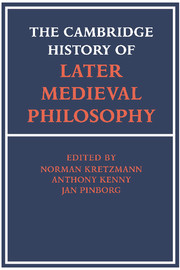 The Cambridge History of Later Medieval Philosophy
The Cambridge History of Later Medieval Philosophy Book contents
- Frontmatter
- Introduction
- I Medieval philosophical literature
- II Aristotle in the middle ages
- III The old logic
- IV Logic in the high middle ages: semantic theory
- V Logic in the high middle ages: propositions and modalities
- VI Metaphysics and epistemology
- VII Natural philosophy
- 25 The interpretation of Aristotle's Physics and the science of motion
- 26 The effect of the condemnation of 1277
- 27 The Oxford calculators
- 28 Infinity and continuity
- VIII Philosophy of mind and action
- IX Ethics
- X Politics
- XI The defeat, neglect, and revival of scholasticism
- Index nominum
- Index rerum
- References
27 - The Oxford calculators
from VII - Natural philosophy
Published online by Cambridge University Press: 28 March 2008
- Frontmatter
- Introduction
- I Medieval philosophical literature
- II Aristotle in the middle ages
- III The old logic
- IV Logic in the high middle ages: semantic theory
- V Logic in the high middle ages: propositions and modalities
- VI Metaphysics and epistemology
- VII Natural philosophy
- 25 The interpretation of Aristotle's Physics and the science of motion
- 26 The effect of the condemnation of 1277
- 27 The Oxford calculators
- 28 Infinity and continuity
- VIII Philosophy of mind and action
- IX Ethics
- X Politics
- XI The defeat, neglect, and revival of scholasticism
- Index nominum
- Index rerum
- References
Summary
The identity and the writings of the Calculators or ‘Mertonians’
In the second quarter of the fourteenth century a collection of works was produced at Oxford whose joint impact on European natural philosophy lasted well into the sixteenth century. The works at the core of this collection are Thomas Bradwardine's De proportionibus velocitatum (1328), William Heytesbury's Regulae solvendi sophismata (1335), and Richard Swineshead's Liber calculationum (usually dated ca. 1350, but probably earlier). Other treatises were linked with these three through common interests and approaches in logic, in mathematics, and in physics or natural philosophy. Among the most closely linked works were Richard Kilvington's Sophismata, Walter Burley's De primo et ultimo instanti and Tractatus primus et secundus de formis accidentalibus (the Tractatus secundus is known better as De intensione et remissione formarum), Richard Billingham's Conclusiones, Heytesbury's Sophismata and the Probationes Conclusionum of his Regulae, Roger Swineshead's De motibus naturalibus, John Bode's treatise on the sophisma ‘A est unum calidum’ and others, the anonymous Sex inconvenientia, and John Dumbleton's Summa logicae et philosophiae naturalis, not to mention many treatises on the usual subjects of fourteenth-century logic – supposition, consequences, obligationes, insolubilia, etc. – or commentaries on Aristotle's physical works and other set books of the medieval curriculum.
Since many of the most famous authors of these works, including Bradwardine, Heytesbury, Richard Swineshead, Burley, Dumbleton, and possibly also Bode, had been fellows of Merton College, Oxford, some recent historians of science call this group of authors the Merton School, although there is little contemporary evidence that they were called Mertonians.
- Type
- Chapter
- Information
- The Cambridge History of Later Medieval PhilosophyFrom the Rediscovery of Aristotle to the Disintegration of Scholasticism, 1100–1600, pp. 540 - 563Publisher: Cambridge University PressPrint publication year: 1982
References
- 22
- Cited by
